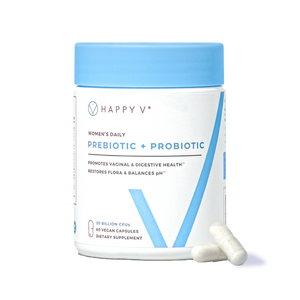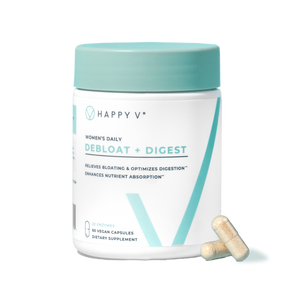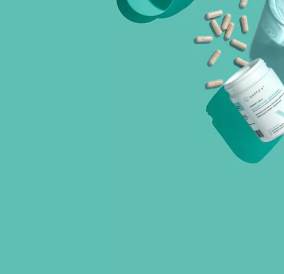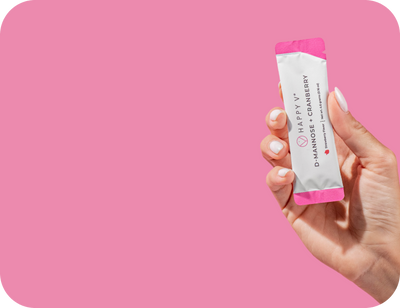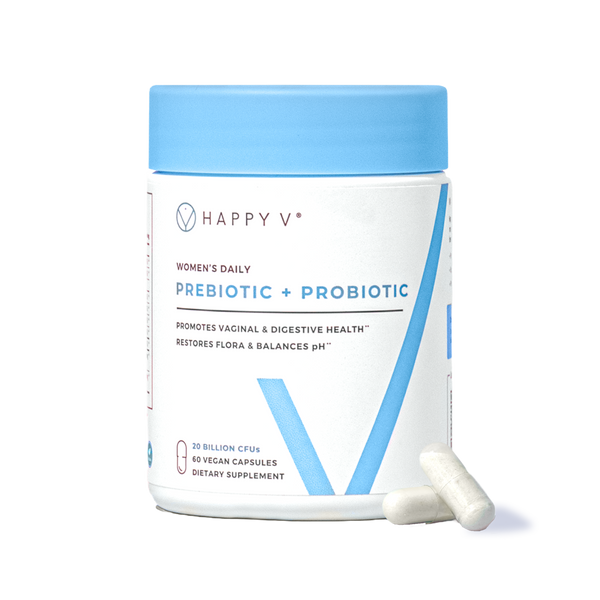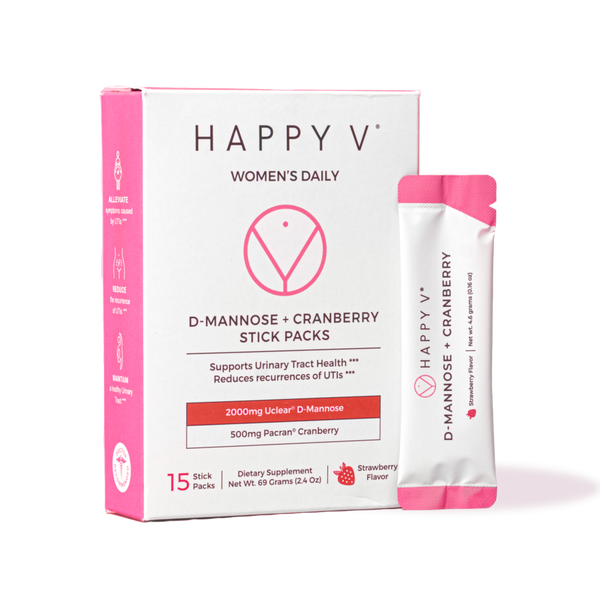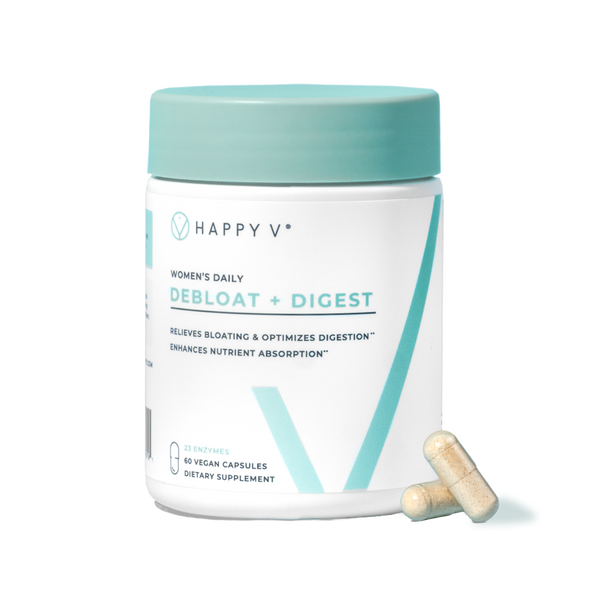- Fact Checked
- November 28, 2025
- 17 min read
What Your Gut Health Means For Your Vaginal Health
Table of Contents
Table of Contents
Right now, at this very moment, your body is teeming with trillions of bacteria and other microorganisms. But before you run to the shower, consider this: these bacteria actually keep you healthy and free from infection, all while keeping your heart pumping and your body thriving.
If you've heard the term "microbiome" before, then you may know it describes the unique composition of bacteria present in your body1. But did you know different organ systems have their own unique microbiome? Two of these systems—the gut and the vagina—rely on bacteria for everything from digesting food to protecting against infections. And strangely enough, these important systems also rely on each other to keep one another functioning properly.
How exactly do these two microbiomes work together, and what does that mean for your overall wellness routine? Let's find out.
This post is for informational purposes only and does not constitute medical advice. See full disclaimer below.
Understanding Your Gut Microbiome
All the microorganisms inhabiting your gastrointestinal tract (think: bacteria, fungi, viruses, and protozoans) are collectively known as the gut microbiome2. The most common types of bacteria in the gut microbiome and organisms are Lactobacilli, Bifidobacteria, Coliform bacteria, Streptococci, yeasts, Proteus, Clostridia, and Staphylococci, though the composition of these microorganisms varies from person to person and is influenced by your diet, environment, stress level, and exercise habits3.
The gut microbiome plays a significant role in women's health, controlling your metabolism, immune system, and hormone production as well as helping your body fight off harmful bacteria and diseases. So basically, when your gut microbiome is in balance, you are feeling pretty great. But when that balance tips and certain types of bacteria are too low and others are too high (in a condition called dysbiosis), you can experience digestive issues, weakened immunity, and problems in other areas, including reproductive health.
What Disrupts Your Gut Microbiome?
As important as the gut microbiome is, it’s also a fairly fragile ecosystem. Whether that ecosystem is in balance or in dysbiosis often comes down to your overall lifestyle, with certain factors contributing to imbalance more than others. The most common culprits for gut dysbiosis include:
Antibiotic use
Antibiotics wipe out bad, infection-causing bacteria and good, infection-preventing bacteria, both in your gut and your vagina. With good bacteria wiped out, bad bacteria have the chance to grow, leading to secondary infections, like yeast infections.
To minimize damage to your microbiome while on antibiotics, take daily oral probiotics during and for the few weeks after treatment4, spacing them at least two hours from your antibiotic dose.
Poor diet choices
A diet rich in processed foods, added sugars, unhealthy fats, and salt feeds harmful bacteria, making you more susceptible to infections5. Support your gut microbiome with prebiotic-rich foods (think: onions, bananas, oatmeal, asparagus, garlic, whole grains) and foods high in healthy bacteria, like yogurt with live cultures, kombucha, kimchi, sauerkraut, and pickles6.
Lack of exercise
Physical activity keeps your immune system healthy, produces anti-inflammatory compounds, and creates an environment where good bacteria flourish. Whether you prefer cycling, jogging, swimming, aerobics, or walking, any movement benefits your gut microbiome, particularly the levels of healthy Lactobacillus bacteria in your gut.
Understanding Your Vaginal Microbiome
Like your gut, your vagina has its own ecosystem. The ecosystem of the vagina is primarily dominated by Lactobacillus species like L. acidophilus, L. crispatus, and L. rhamnosus7. These beneficial bacteria produce lactic acid, keeping your vaginal environment acidic, which kills harmful bacteria and yeast before they can multiply and cause infection8.
Similar to the gut microbiota, the composition of bacteria within your vaginal microbiome depends on factors like diet, stress, exercise, hygiene, and more. Most vaginal infections (including bacterial vaginosis and yeast infections) are not just caused by the growth of bad bacteria, but by a lack of protective bacteria9. When something causes beneficial Lactobacillus levels drop, problematic bacteria like Gardnerella vaginalis or yeast like Candida can take over10, leading to bacterial overgrowth and the uncomfortable symptoms that come with it.
What Disrupts Your Vaginal Microbiome?
Also like your gut, your vaginal microbiome is as delicate as it is complex. Many things can influence the balance of bacteria in your vagina and put you at higher risk for vaginal infections, including:
Diet
Everything we said about diet and gut health also applies to vaginal health. Highly processed foods and added sugars promote harmful bacteria and yeast overgrowth, contributing to dysbiosis and infection.
Antibiotics
Ditto again when it comes to antibiotics. While antibiotics may be necessary to clear an infection, they should not be used regularly, as they can slow the growth of Lactobacillus or eliminate these species completely, putting you in a prolonged state of dysbiosis.
Douching
Like antibiotics, douching removes both good and bad bacteria11, which can throw your entire microbiome off-balance. The douching process can also force infection-causing bacteria further up into your vagina, potentially increasing the severity of vaginal infections if they occur. More than all that, douching is totally unnecessary because your vagina cleans itself (cool right?). The best approach to staying fresh is gentle external washing with warm water, which won't disrupt your vaginal flora.
Poor hygiene
Improper wiping, staying in sweaty workout clothes for too long, and wearing synthetic underwear instead of breathable cotton can all contribute to the transfer or overgrowth of harmful bacteria.
Multiple sexual partners and unprotected sex
While you are in charge of your sex life, know that having multiple sexual partners and unprotected sex increases exposure to potentially harmful pathogens and can temporarily alter vaginal pH12. Consider barrier protection or other preventative measures to lower your risk of imbalance.
How the Gut & Vagina Work Together
While we often talk about different bodily systems in their own little silo, the truth is that the systems of your body all work together. This is especially true for your microbiomes. When one microbiome is healthy, it supports the health of the other. The gut and vagina influence each other in two main ways: through inflammation and hormone metabolization13.
The Inflammation Connection
When your gut is imbalanced, it triggers systemic inflammation that impacts your entire body, including your vagina. This inflammation can stimulate immune responses that alter vaginal pH, making it easier for harmful bacteria to take hold.
The Hormone Highway
Your gut contains a specialized bacterial collection called the estrobolome, which influences how your body metabolizes estrogen14. Since estrogen is crucial for maintaining healthy vaginal tissue and promoting glycogen production (which feeds those beneficial Lactobacilli), disruptions in the estrobolome affect vaginal health15. This connection is particularly important during menopause, when estrogen levels naturally decline and can impact both gut and vaginal ecosystems16.
Understanding When Your Microbiomes Are Out of Balance
One of the biggest signs your microbiomes are out of whack is the appearance of uncomfortable symptoms.
For your vaginal microbiome, this could include signs like:
- Recurrent yeast infections or BV17
- Odor or unusual discharge
- Itching, burning, or irritation
- pH that feels “off” even without clear symptoms
- UTIs that keep coming back
- Difficulty conceiving or changes in cervical mucus
- Irritation after sex, your cycle, or antibiotic use
As for your gut, symptoms of dysbiosis tend to show up quickly and include:
- Bloating, gas, constipation, or diarrhea18
- Food sensitivities that seem to come out of nowhere
- Fatigue, inflammation, or weakened immunity19
- Trouble digesting certain foods
- Sugar cravings or blood sugar swings
- Skin flare-ups (acne, eczema, dryness)20
- Mood changes (brain fog, irritability, low resilience to stress)
While these symptoms are a reliable sign that something isn’t right when it comes to the balance of healthy bacteria in your microbiomes, at-home tests are available to test both your vaingal and gut microbiomes. These can potentially give you insights that can guide your treatment, if you know how to read the results.
At-Home Vaginal Microbiome Tests
At-home vaginal microbiome tests are available in many local drugstores and pharmacies. You collect a small swab at home (similar to a gentle Q-tip), send it to the lab, and get a detailed report about the bacteria living in your vagina.
Report results typically include information about your overall Lactobacillus levels (a healthy vagina is usually 90% Lactobacillus) and what species you have. They can also let you know about the presence of certain bacteria, like Ureaplasma or Mycoplasma, that can influence conception or contribute to inflammation.
For many companies, a read-out includes:
- Your microbiome “type” (you can read more on that here)
- Your protective vs. disruptive bacteria
- Whether your pH and Lactobacillus levels look healthy
- Any concerning microbes or red flags
- Personalized recommendations to help restore balance (like targeted probiotics, prebiotics, or hygiene adjustments)
Though these at-home kits are often seen as a way to avoid a doctor’s office visit, it is always a good idea to send the results to your provider so they can help make sure you are interpreting them correctly and give you an actionable next step.
At-Home Gut Microbiome Tests
At-home gut microbiome tests work a lot like vaginal tests, but instead of a swab, you provide a small stool sample (usually collected with a clean catch card or tiny scoop included in the kit). You send it to the lab, and they analyze the bacteria living in your gut to help you understand how well your digestive system and immune system are functioning.
Your report usually outlines how diverse your gut bacteria are (higher diversity is often linked to better digestion and overall health) and whether you have elevated levels of microbes that may contribute to inflammation, bloating, or food sensitivities. Many kits also flag patterns tied to metabolism, nutrient absorption, and immune function.
For most companies, a typical report includes:
- Your overall bacterial diversity
- Beneficial vs. potentially disruptive bacteria
- Markers tied to digestion, metabolism, and inflammation
- Notes on microbes associated with food intolerances
- Personalized recommendations for foods, probiotics, and prebiotics to support your gut
Who Should Consider Testing?
Understanding the nuances of your microbiome isn’t necessary for many people looking to improve their gut and vaginal health. Often, the symptoms are the only “result” you need to tell you something isn’t right.
People who do microbiome testing typically:
- Experience recurring BV, yeast infections, or UTIs
- Have unexplained gynecological symptoms
- Are trying to conceive or preparing for fertility treatments (including IVF)
- Have chronic digestive issues
- Recently took antibiotics or have hormone-related shifts
- Want a clearer picture of your gut or vaginal health before starting targeted probiotics and prebiotics
Again, any at-home test results should be shared with your provider so they can help you come up with a treatment plan that’s also rooted in your health history. If you do pursue testing, it can also be helpful to test again in 6 months to see how your microbiomes have changes and potentially improved.
The Power of Probiotics and Prebiotics
Because the two microbiomes are so deeply connected, caring for and improving the health of both your gut and vagina often involves the same basic habits. One of those habits with a lot of scientific backing is daily probiotics and prebiotics. When taken together consistently, they’re one of the most effective ways to support both systems at once.
What Are Probiotics?
The WHO defines probiotics as “live microorganisms which, when administered in adequate amounts, confer a health benefit on the host.”21 Think of them as tiny wellness assistants that help manage bad bacteria, support immunity, and keep both your gut and vaginal microbiomes running smoothly.
While many people think you can get probiotics through foods like yogurt, that’s often not the case. Yogurt contains live bacteria that can have health benefits, but when it comes to probiotics specifically, the best way to get them is through a daily probiotic supplement that’s made with clinically studied strains.
How Probiotics Support Gut and Vaginal Health
There are several key ways that probiotic strains support gut and vaginal health, with the most studied being:
Digestive support
Probiotics help keep digestion moving—literally! They have the potential to ease bloating, gas, constipation, diarrhea, and symptoms of IBS22. Some strains can even support remission in inflammatory gut conditions, like ulcerative colitis and Crohn’s.
Vaginal pH balance
Lactobacillus strains produce lactic acid, which keeps vaginal pH between 3.8 and 4.5 (aka a slightly acidic environment where harmful bacteria struggle and good bacteria thrive). This helps support vaginal comfort and reduces the likelihood of common infections, like BV and yeast infections.
Immune support
Because so much of your immune system lives in your gut (some estimates say it’s as much as 70%!), probiotics help keep your defenses strong and responsive throughout your whole body, including in your vagina, which is critical if you have a history of vaginal infections.
What Are Prebiotics?
If probiotics are the superheroes, prebiotics are their fuel. Prebiotics are nondigestible fibers that feed your good bacteria and help them grow, multiply, and stay strong.
You’ll find prebiotics in foods like garlic, onions, asparagus, oats, bananas, berries, mushrooms, pistachios, and whole grains. You can also find probiotic supplements that also contain prebiotics to supercharge your supplementation.
The Best Probiotic Strains for Gut + Vaginal Support
We mentioned that certain probiotic strains offer health benefits to your gut and vagina. This means that others don’t. When choosing a supplement, look for clinically studied strains that have been shown to support digestion, immunity, vaginal pH, and microbial balance. Here are the powerhouse strains to look for:
- Lactobacillus acidophilus (LA-14®) – A foundational strain for gut and vaginal wellness, known for supporting digestion, healthy immunity, and the growth of protective vaginal bacteria23
- Bifidobacterium lactis (HN019™) – A gut-health superstar that promotes regularity, strengthens immunity, and works synergistically with Lactobacillus strains to influence vaginal balance
- Lactobacillus rhamnosus (HN001™) – A multitasking strain shown to support gut barrier integrity, immune function, and the maintenance of a healthy vaginal pH
- Lactobacillus crispatus (CCFM1110™) – One of the most important strains for vaginal protection, helping maintain an acidic pH while also supporting overall microbial balance
- Lactobacillus gasseri (HLG13™) – Known for its role in metabolic and digestive health while also promoting a stable, Lactobacillus-dominant vaginal microbiome24
- Lactobacillus reuteri (HR7™) – Helps reduce the growth of harmful bacteria in both the gut and vagina and supports whole-body immune and microbiome harmony25
Happy V combines all these clinically studied strains—plus those beneficial prebiotics—into one convenient daily capsule designed to nourish both your gut and vaginal microbiomes. Our Prebiotic + Probiotic is science-backed, easy to stick with, and designed for whole-body wellness from the inside out.
How Long Does it Take for Probiotics To Work?
Probiotics don’t work overnight. Most people need a few weeks to a few months of consistent use to see meaningful health improvements. The timeline depends on your diet, stress levels, medications, sleep, and the specific symptoms you're trying to improve.
Some people notice early shifts, like reduced bloating or more regular digestion, within the first couple of weeks. But deeper or more chronic issues, such as recurring BV, yeast infections, IBS, or long-standing gut imbalance, usually take longer.
Long story short: supporting and reshaping a microbiome is a gradual process, and consistency is key.
Common Myths About Probiotic Use
Though probiotics are becoming incredibly common, there are common myths that can lead to ineffective or unsafe use. The biggest myths we see are:
Myth #1: All Probiotics Are the Same.
They’re absolutely not. There are hundreds of different Lactobacillus strains, and not all of them have proven health benefits. Even strains with the same name, like two versions of Lactobacillus acidophilus, can behave completely differently in the body depending on how well they’ve been studied.
What matters most is strain specificity. Clinically studied strains have documented benefits, while unstudied strains may not do much at all. This means that generic probiotics that list broad categories (think: “Lactobacillus blend”) don’t tell you anything about what you’re actually getting or whether it’s been studied.
Myth #2: You Must Insert Probiotics Into the Vagina to Help with Bacterial Vaginosis or Yeast Infections.
Not true, and for many people, not realistic or convenient either. While probiotic suppositories do exist, they aren’t necessary for supporting vaginal health. What matters far more is choosing an oral probiotic capsule like Happy V’s that’s actually designed to survive your stomach acid and make it to the intestines, where it can support the gut–vagina connection.
Myth #3: Yogurt, in Any Form, Is a Probiotic.
Plain yogurt naturally contains beneficial bacteria, but they do not contain the targeted strains of probiotics that we’ve been discussing so far. More than that, many commercial yogurts are packed with sugar, which can actually feed harmful bacteria and harm your vaginal health.
Simple Ways to Support Both Microbiomes
Probiotics can’t overcome an unhealthy lifestyle. To be most effective, you must pair probiotics with other lifestyle changes, like:
Be Smart With Antibiotics
Antibiotics can be lifesaving, but they also wipe out good bacteria in both your gut and vagina. Take them only when necessary, and pair them with a high-quality probiotic during and after treatment to help rebuild balance.
Practice Supportive Vaginal Hygiene
Small habits go a long way. When it comes to preventing microbiome imbalance:
- Change out of sweaty clothes or swimsuits quickly
- Choose breathable cotton underwear
- Change tampons, pads, liners, or menstrual cups regularly
These all help reduce moisture buildup and minimize bacterial overgrowth.
Avoid Over-Cleansing
Your vagina is self-cleaning. Douching or applying scented washes and creams can disrupt your natural microbiome. The best approach? Rinse with warm water during showers and after sex, and let your body do the rest.
Stay Physically Active
Movement supports better digestion, improves circulation, helps regulate hormones, and lowers inflammation, all of which benefit both your gut and vaginal microbiomes. Even light movement, like walking or stretching, can make a difference.
Frequently Asked Questions
Can Gut Problems Really Cause Vaginal Infections?
While gut problems don't directly "cause" vaginal infections, an imbalanced gut compromises your immune system and overall bacterial balance, making you more susceptible to vaginal infections.
Should I Get My Microbiome Tested?
If you're experiencing recurrent infections, unexplained symptoms, or difficulty conceiving, testing may provide you with helpful insights, though many find they aren’t necessary. Just remember that results should always be interpreted by healthcare provider.
How Does My Menstrual Cycle Affect My Microbiomes?
Hormonal fluctuations create changes in both gut and vaginal bacteria. Estrogen peaks strengthen lactobacillus populations, while drops during menstruation temporarily increase vaginal microbial diversity and pH. Period blood's higher pH creates conditions where harmful bacteria thrive, which is why some women are more prone to infections during or after their period.
Should I Take Separate Probiotics for Gut and Vaginal Health?
Not necessarily. Many probiotic strains, especially Lactobacillus species, benefit both systems. Look for a comprehensive formula with clinically studied strains that support both gut and vaginal health.
Will Probiotics Help with Yeast Infections?
Yes, quality probiotic supplements can help prevent and manage yeast infections. Lactobacillus strains maintain the acidic vaginal pH, which naturally inhibits Candida overgrowth. Many women find that taking probiotics regularly reduces the frequency of recurring yeast infections, especially after antibiotic use.
Final Thoughts
The connection between gut and vaginal health might seem complex, but supporting both doesn't have to be. By understanding how these systems work together and making intentional choices about diet, lifestyle, and supplementation, you create an environment where beneficial bacteria thrive throughout your body.
Keep the Conversation Going
- Visit our blog for more women's health tips.
- Join our private Happy V Facebook group to hear from others who've been there.
- Explore supplements designed to support your vaginal health journey.
Disclaimer: This blog is for informational and educational purposes only and is not intended to diagnose, treat, cure, or prevent any disease. Statements about supplements have not been evaluated by the Food and Drug Administration. For more information about vaginal infections, visit the CDC or speak to a licensed healthcare provider.
